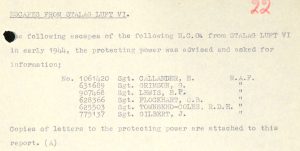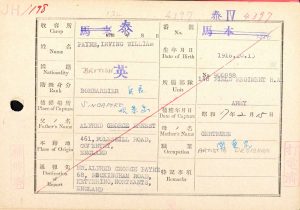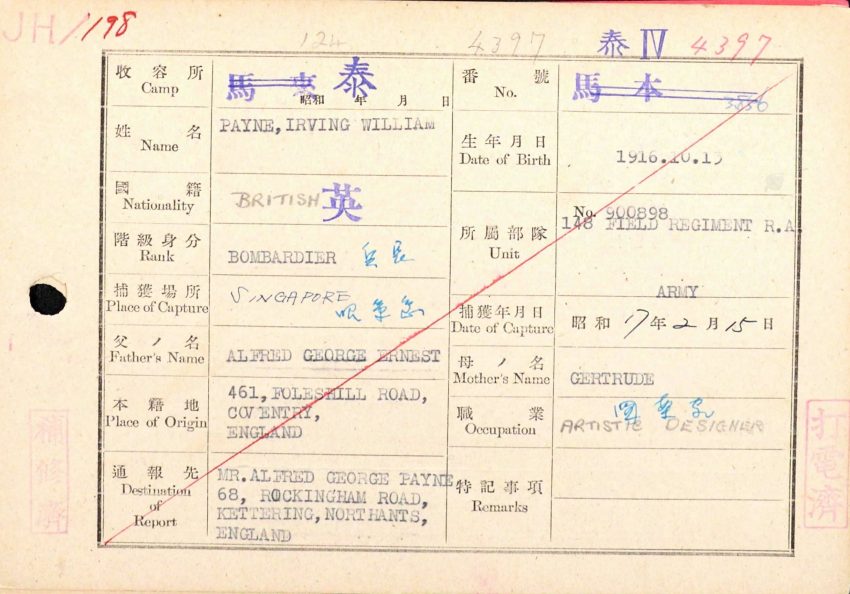Was your ancestor one of the hundreds of thousands of Allied prisoners captured during the Second World War? Discover details about their time as a prisoner with our WWII, Allied Prisoners of War, 1939-1945 collection. A great starting point in your research journey, the records concern prisoners from Britain and other Allied nations who served with the army, navy, air force and merchant navy.
Exploring the WWII, Allied Prisoners of War, 1939-1945 collection
You may have heard a family story that your ancestor was taken prisoner during WWII. Perhaps they were part of the British Expeditionary Force covering the Dunkirk evacuations or were amongst the survivors picked up from a merchant ship sunk crossing the Atlantic. Maybe they were part of an aircrew who managed to bail from their bomber and were captured in enemy territory. While service records are a fantastic source of information about a person’s military service, they often lack detailed information about their time as a prisoner of war. Prisoner of war records are, therefore, a valuable source, filling in the gaps left by a service record.
Our UK, Allied Prisoners of War, 1939-1945 collection comprises rolls and lists of prisoners of war, in addition to index cards for prisoners captured by the Japanese. They vary in scope and content: lists of prisoners held in Europe generally contain the person’s prisoner number, army/service number, name, rank, unit and camp code. Index cards for prisoners held by the Japanese, however, contain significant military and genealogical information. More on these shortly.
Try beginning your search of the collection with the person’s name and service number if you know the latter. Remember to use variations in your searches. For example, search using their full name and initials, as many prisoners are recorded under their surname and initials, as indicated in the image below:

For rolls and registers relating to prisoners held in Europe, such as the example above, note that the camp number features instead of the camp’s name.
FWR Tip: If you scroll to the early pages of the file, you will usually discover a key noting the names of the different camps.
You may encounter multiple entries for one individual in the rolls and registers.
Occasionally, files within the collection contain reports and correspondence, such as this file relating to Stalag Luft VI in modern-day Lithuania, containing information on escape reports and incidents within the camp. These could add further detail to your ancestor’s wartime story. Below is an extract from the file, concerning escapees.

When researching a prisoner held by the Japanese during WWII, you may encounter a variety of records. These vary from basic nominal rolls to more detailed prisoner rolls, containing information such as camp code, date of capture, date of liberation and remarks such as ‘missing on board ship’. You may find death registers, like this one compiled by the Bureau of Records and Enquiry, noting the fate of those who died fighting the Japanese.
Japanese index cards
Of particular significance are the index cards relating to prisoners held by the Japanese; a valuable resource if you are able to identify one for your ancestor. The cards generally relate to British personnel, but you may find cards for other nationalities serving with British forces.

Above, we see the index card for Bombardier Irving William Payne of the Royal Artillery. The cards are packed with valuable military and genealogical clues. Information such as parents’ names, the prisoner’s date and place of birth and addresses are recorded, welcome additions for family historians. Details, such as their date and place of capture, will help you search for your ancestor in other POW collections, allowing you to develop their story and add further context.
There are factors to consider when researching Japanese index cards. Firstly, you may notice the date of capture is written in Japanese format. As a result, you will need to convert the year from the Japanese calendar for the Shōwa era, which is the period of rule by Emperor Shōwa.
According to Bombardier Payne’s index card, he was captured on ’17 2 15′.
17 is the year, the only aspect requiring conversion, while 2 is the month (February), and 15 is the day. Below is a handy guide for converting the years:
16 = 1941
17 = 1942
18 = 1943
19 = 1944
20 = 1945
We now know that Bombardier Payne was taken prisoner on 15 February 1942, during the fall of Singapore.
FWR Tip: A red line through the card generally indicates that the person in question had died in captivity. Sadly, Bombardier Payne died on 12 September 1944. His date of death was recorded on the back of the card, emphasising the importance of consulting both sides of the record.
The back of the card will require more in-depth translation.
Additional steps for researching prisoners of war
What are your next steps after finding someone in our UK, Allied Prisoners of War, 1939-1945 collection? You can explore additional prisoner of war collections available on Forces War Records, which complement the collection featured in this blog. Head over to the Browse section of our website and search the Publications field for words like ‘prisoner’ or ‘POW’.
If the prisoner you are researching survived, it is worth consulting the Liberated Prisoner of War Interrogation Questionnaires, available on Ancestry. The questionnaires often provide further information on the camps an internee was held at, along with incarceration dates. Sometimes, they contain information on escape attempts or sabotage work carried out while a prisoner of war.
TNA’s escape and evasion reports are a useful source for researchers investigating prisoners who escaped their camps and their efforts to evade the enemy.
Finally, the International Committee of the Red Cross (ICRC) in Geneva, Switzerland, holds records relating to WWII prisoners of war. The ICRC employs a quarterly quota for requests, so it is worth checking their website for upcoming submission windows.
There are many collections available on Forces War Records to help you research your ancestors’ military service. You can view all our records via the Browse tab, with options available to narrow the collections by country, conflict or service branch.
We’re always here for you if you need help or advice with your research. Why not follow us on Facebook and submit a question to one of our monthly military genealogy Q&As? You can also send a query via the Document Expert section of our website.


